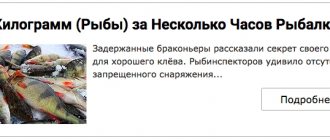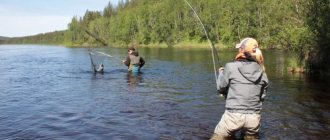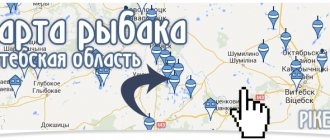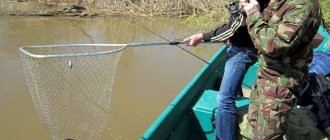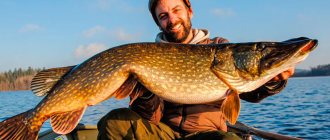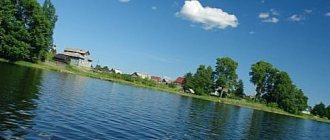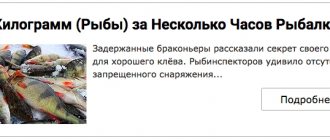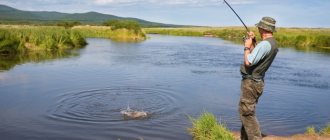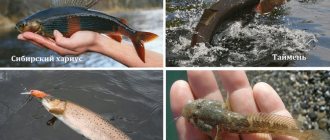What kind of fish is found in the river?
The Klyazma River originates in the swamps of the Solnechnogorsk region and is one of the largest rivers in the Moscow region. If in the upper reaches the width of this water artery rarely exceeds 10 m, then in the lower reaches it can be more than 200 m. In the middle reaches, the Klyazma River flows through the Pirogovskoye and Klyazminskoye reservoirs.
Despite the unfavorable environmental situation and other negative factors, a fisherman can catch on this reservoir:
- roach;
- bleak;
- ruff;
- gold and silver crucian carp;
- rudd;
- bream;
- perch;
- pike;
- ide;
- chub;
- asp;
- subusta;
- saberfish
On a note! Small roach, bleak and ruffe can be caught throughout the Klyazma River both in the warm season and from the ice.
These species prefer to peck on caddis flies, bloodworms and maggots. Gold and silver crucian carp are caught in small creeks and bite better on dung worms. There are fewer rudd in the river every year. The main catches of this fish occur in the spring. You can use one or two maggots or caddis flies as bait.
Asp on Klyazma rarely grows to trophy size, but catching it can be very exciting.
Bream weighing up to 1.5 kg. can be successfully fished in the middle and lower reaches of the river. Feeder gear is often used to catch it. Since there is no strong current in the reservoir, there is no point in using a very powerful rod with a large test. A fishing rod with a test range of up to 60 grams is quite sufficient. During the daytime, a fisherman can count on trophies weighing no more than 500 grams. At night it is possible to catch more respectable specimens. The traditional bream bait for these places is a bunch of dung worms or rolled oats. This fish is caught mainly in the area of the channel edge, but at night it can go to the coastal zone.
Pike and perch are among the most common underwater inhabitants of Klyazma. If perch can be caught at any time of the year, then the bulk of pikes are caught by anglers in the spring and summer. Catching these predators is carried out mainly with spinning gear. In winter, anglers more often use poles and fishing rods for vertical trolling. The main sites for these fish are coastal pools.
The ide is more common in the middle reaches of the river and lives at a depth of no more than 2 m. This species, as a rule, is found at the border of calm water and current and is often adjacent to the chub. The best time to catch these fish on the Klyazma River is May and the first half of June, when most insects are actively emerging. You can catch ide and chub using spinning, float or fly fishing gear. It is almost impossible to catch these underwater representatives on the river in winter.
Many spinning anglers come to this reservoir to catch asp. This predator is found in the area of numerous rapids located in the middle reaches of the Klyazma. In fishermen's catches, specimens weighing no more than 1 kg are more often found. Asp can be caught well throughout the summer using small floating wobblers and spinners.
If back in the nineties there were quite a lot of sabrefish and podust in the river, today it is extremely rare to catch these fish. Chekhon is occasionally caught on light spinning tackle in the middle reaches of the river. Its average weight is 200 grams. Podust often bites at the confluence of the following tributaries into the Klyazma:
- Teaching;
- Nerl;
- Kirzhach;
- Chernogolovka;
- Sudogda.
Important! Podust fishing is carried out on the rapids itself. To catch it, Bolognese tackle is often used. The bait is usually a dung worm or a bunch of maggots.
In the middle of the last century, it was possible to catch catfish and sterlet in the waters of the Klyazma, but today these fish species are absent from the river. The depletion of fish stocks in this waterway is to blame not only for the unfavorable environmental situation, but also for poaching.
In general, on Klyazma it is very important to fish channel slopes
It is on them that large pike and perch come to fatten. Often these predators go along the slope to the feeding areas. And they settle in numerous shelters - deep coastal snags, near a bushy shore, where the roots are washed away by water. Often the movement of fish is minimal - across the river from the “wooden fortress” to the riverbed edge and back. And the fisherman needs to choose the right fishing tactics. All these coastal debris with backwaters, of course, look promising, and it is obvious that there must be a large predator here. He is, but often passive. You can only catch it by accident by putting the bait right under the fish’s nose, risking a dead hook. And the usual story: you suffer in such places, you try to stick the bait into the very snag, and nothing happens. You throw into the clear, towards the fairway edge, and immediately there is a bite of an excellent fish, and then another. Yes, this edge is often silent, but I always check it regularly, selecting baits that can confidently strike along the bottom here. The local predator loves this “teal” very much.
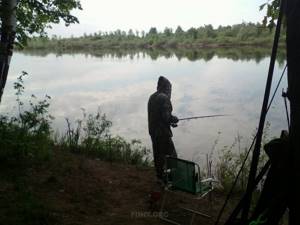
When catching large whitefish, it is even more important to separate the concepts of where the fish settles and where it feeds, because with donks you “stick” to the place. The same bream does not sit in the pits forever even in the pre-winter period. This is where it lives, and goes out to feed at the entrances, exits of pits, and even much further - into the expanse of feeding reaches, especially when the weather is fairly warm and calm. I remember about thirty years ago, when there were no feeders, I watched how experienced local fishermen dragged large bream in late autumn, setting two-meter poles without any reels. The fishing line is a couple of tens of meters, the equipment is a weight and a hook, on which there are a dozen maggots or steamed peas. They were exhibited precisely on reaches with depths of up to 2.5 m, about thirty meters above the pit. And when a flock of white bream entered the area, almost simultaneously the bells on dozens of poles began to ring with a pleasant ringing. This lasted no more than half an hour, then, as a rule, this fish returned again in the afternoon, making a large circle around its hole. Since then, the bream has not changed its habits, it has simply become more careful, and does not tolerate noise and trampling on the shore.
Is it possible to eat Klyazma fish?
Analyzes carried out by specialists have shown that eating fish that live in the upper and middle reaches of the Klyazma can negatively affect human health. The permissible standards for the content of iron and phosphorus in meat are tens of times exceeded. In addition, fish meat has a specific smell, so even cats do not eat it.
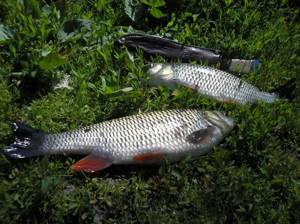
Fishermen from the Moscow region come to Klyazma in the hope of catching chub, and they often succeed.
The lower section of the river is located in less populated areas, which has a positive effect on water quality. Fish caught in the lower reaches of the Klyazma can be eaten without fear and has very good gastronomic characteristics.
The most promising places for fishing
There are several places on the Klyazma River that are especially popular among fishermen in the Moscow region. The fish bite in these areas is most stable, so the fisherman can expect very interesting fishing.
Plot in the Orekhovo-Zuevo area
Fishermen often come to the site in the Orekhovo-Zuevo area in the summer for bream. Large bream weighing up to 1.5 kg are caught mainly at night. Peak fishing is usually observed from 23:00 to 3:00. The fishing area should be pre-fed, and it should be taken into account that in order to attract large fish, cut worms must be added to the bait. The minimum volume of the bait mixture must be at least 2 kg.
Attention! You need to feed the selected point before dark so that the bream have time to gather in the feeding area before the start of the night bite.
In October, small pike perch, pike and perch are well caught in this area. Fishing is carried out using jig spinning baits. When choosing gear, you need to take into account that the most promising points are 60–80 m from the shore, so the length of the spinning rod should be at least 2.7 m.
Near the town of Petushki
Places on the Klyazma near the town of Petushki are characterized by a large number of creeks and bays in which you can effectively fish:
- crucian carp;
- rudd;
- ide;
- pike;
- perch
The depth of the local bays can reach 3 m, so good fishing in the Petushki area is possible not only in summer, but also in winter. Throughout the winter period, pike bite on the fishing gear. The most active perch bite is observed during the first ice and in April. Crucian carp, ide and rudd can be caught well in the bays from May to September. Since the Klyazma water area in Petushki becomes very overgrown in summer, it is better to use summer jig tackle to catch white fish. For the convenience of fishing in these places, the angler will need “swamp” boots.
Near Korolev
Interesting places for fishing on the Klyazma are located in the city of Korolev. You can fish both from the city embankment and beyond. In this area you can find many deep holes in which large pike and pike perch are kept. The luckiest fishermen manage to catch predators weighing more than 5 kg. By-catch may also include perch weighing up to 600 grams. During the period of open water, fishing is usually carried out with spinning tackle. “Edible” rubber is more often used as artificial bait, which is due to increased fishing pressure in this section of the river. The most catchy color of silicone bait on Klyazma is “machine oil”.

Large roaches begin to bite on the last ice on Klyazma.
In winter, those who like to catch bream and roach come to Korolev. They are caught with both jigs and float gear. If you fish on the main channel, where there is a noticeable current, then use the winter version of the feeder.
Good places for fishing are located in the area of the city of Kovrov. In this section, the Klyazma is deep and full of water. Here you can often find fishermen trolling. Their main prey is pike perch. In addition to the “fanged” one, good pike and asp are caught in these places.
Fishing on Klyazma
Fishing on the Klyazma River
The Klyazma River is the second longest river in the Moscow region.
It also crosses the territories of the Vladimir, Ivanovo, and Nizhny Novgorod regions and is a left tributary of the Oka River. The length of Klyazma is about 700 kilometers, the width ranges from twenty to two hundred meters; Klyazma is fed by melt waters. It becomes covered in ice in the month of November, and ice drift begins in mid-April.
The river is distinguished by its picturesque banks with sandy beaches and small birch groves. The water in the river is quite clear and clean. An excellent holiday on Klyazma is combined with an ideal place for fishing, and those who come here to relax and at the same time treat themselves to pleasant fishing are always satisfied. Due to the fact that the Klyazma flows through several regions, fishing in each region is different.
In the upper reaches of the Klyazma it is not particularly clean, since industrial enterprises and nearby settlements do their “dirty” business. However, moving further to the southeast, the water in the river acquires transparency and becomes cleaner.
The inhabitants of Klyazma are typical representatives of the ichthyofauna. And despite the fact that the migration of fish has become somewhat difficult due to the creation of reservoirs on the river, Klyazmensky and Pirogovsky, there is a lot of fish here. In addition, the water balance maintained by these same reservoirs has a beneficial effect on the life and development of fish. There are different fishing methods used here, mostly classic ones.
Sterlet was once released into Klyazma. Nowadays, the population of this fish has decreased significantly, and its fishing is prohibited. Among the predators caught here are pike, asp, perch, and chub. In some places you can even catch a catfish. Among the inhabitants belonging to white fish, golden bream, bleak, roach, ide, silver bream, and dace live here. These fish are usually caught on dumps. But especially catchy places should be looked for on steep banks.
Also interesting: Fishing on the plow
It is better to catch chub and ide on small rifts, which are characterized by significant differences in depth. The chub, in addition to the riffles, is also found on the banks where trees grow. Tree branches reach down to the water, and insects falling from the leaves are a delicacy for the chub. It is in such places that this fish waits for its prey.
In a word, if you see that trees are growing on the banks of the river, and the branches are descending low to the water, feel free to stop and settle down for successful fishing and a wonderful vacation. Crucian carp are not found very often in the river. These can be places with both strong currents and calm ones. Crucian carp can always be found on dumps and near small coves.
The number of asp in Klyazma has decreased significantly. But it is possible to catch this fish if you hunt for it close to the mouth of the river. True, you won’t be able to pull out a large trophy, since the asp has been crushed and does not reach the same size as it did a quarter of a century ago. And, unfortunately, you won’t be able to see an asp fight that looks like a “police turnaround.” Perch and bleak can be caught in any section of the river. For some reason, perches do not grow to large sizes.
Pike can also be found everywhere: in some places there is more of it, in others there is less. But it lives most often in wide areas with a pronounced boundary between calm and fast currents. It is curious that Klyazma fishermen catch bream, perch and catfish using crayfish, which are previously cleaned of shells. For fish, crayfish meat is a delicacy. Burbot on Klyazma is usually caught with bottom gear. Live bait and worms are used as bait. Roach and silver bream are also caught on the bottom, but live bait with a worm is replaced with maggots if it is warm.
Also interesting: Fishing on pekhorka
The worm is used in the cold season. Perch are caught using a medium-sized twister and vibrotail. In the spring, in the upper reaches of the river, fishing for roach, bream, and ide is popular. The size of these fish is small, but the number can please the eye of any angler, be it a professional or a beginner. The section of the river beyond Noginsk is heavily littered and unsafe; It’s better not to catch ides and bream there.
Winter fishing is also developed on Klyazma, when the same fish are caught as in open water. With the exception of crucian carp, ide and asp. The good news is that there are not only paid places here, which, without a doubt, are very comfortable for fishing and recreation. The main thing is that the whole process of fishing gives you pleasure and the joy of communicating with nature.
Category: Fishing in the Moscow region
Fishing on the Klyazma Reservoir
Many fishermen near Moscow prefer to fish not on the Klyazma River, but on the Klyazma Reservoir, into which it flows. In this reservoir there are all types of fish that live in the river, but fishermen’s gear more often comes across:
- roach;
- silver bream;
- bream;
- perch;
- pike;
- zander;
- burbot.
White fish can be caught near the Vodniki platform, where there are several bays with good access to the water. Due to the fact that the depths begin close to the shore, you can fish not only with feeder gear, but also with a fly float rod. Near the villages of Sorokino and Syomkino there are many places for fishing for roach and perch.
On a note! There are fishing spots in the Alexander Harbor, where you can catch not only peaceful fish, but also pike perch.
In winter, burbot is often caught on jigging gear. You should look for this predator in deep holes located not far from the Klyazma fishing base, as well as on the channel edges of rivers flowing into the reservoir. The Klyazma Reservoir is famous for its catches of large pike. The largest specimens of this predator are caught in the autumn.
Despite the strong fishing pressure, fishing on the Klyazma and Klyazma Reservoir can be very productive and interesting. The accessibility of these reservoirs makes them favorite vacation spots for many fishermen in the Moscow region.
Where to stay
Along the entire length of the river, recreation centers and tent camps have been built for lovers of fresh air and water. Not all of them specialize in fishing, however, most will be happy to show you the best fishing spots. If nature is not your thing, you can rent a house or a hotel room - fortunately, the river flows past several cities. If you come to fish with your family and children, you should choose a place closer to the beach: then the kids won’t get bored and won’t bother you at important moments. There are both free and paid places on the river. The latter are more convenient for those who just want to relax. A place, fishing rods and bait will be fully prepared for you, and the owners have taken care of the catch in advance by putting the necessary types of fish into the water. If you don’t want to pay extra money, you can simply rent the necessary gear or buy it in local shops.
Fishing on Klyazma
Reviews
Vladimir: Recently I was in the upper reaches of the Klyazma. In half a day I caught 5 pike weighing up to 600 grams. and 3 small perch. For such a small river, this is quite a decent result.
Sergey: Over the weekend I tried to catch a chub in the middle reaches of the Klyazma. The fish reacted only to the cockchafer and did not pay any attention to artificial baits. In the end I caught 7 pieces.
Georgy: Since last week, bream began to actively bite at the Klyazma Reservoir. It is caught mainly at night, but decent specimens are also caught during the day.
Free fishing in the Vladimir region
The water resources of the Vladimir region are extensive; there are more than 300 lakes in the region. There are also many rivers, all of them belong mainly to the Volga basin. The reservoirs are mostly large, but there are also plenty of small ones, which makes it possible for many species of fish to grow and reproduce. Accordingly, fishing is extremely popular; everyone, young and old, fishes here.
In general, today in all the reservoirs of Vladimir you can count about 40 species of different fish. Mainly bites: dace, crucian carp, ruffe, burbot, perch, tench, roach, gudgeon, bleak, silver carp, ide, pike. Of course, not every place is suitable for fishing; in some places there are restrictions on fishing.
Here are the TOP 10 best places where you can fish for free in the Vladimir region:
Oka River
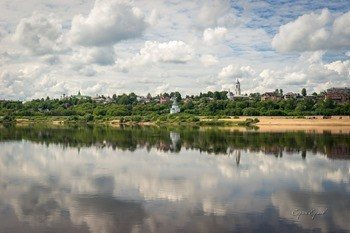
Description, what kind of fish is found, how to get there:
In the Oka there are such species of fish as carp, crucian carp, cupid, bream, chub, carp, rudd, tench, roach, barbel, ide, pike perch, perch, burbot, catfish, pike, and crayfish. One of the best places for fishing is considered to be in the area of the village of Dmitrievy Gory in the Melenkovsky district.
GPS coordinates: 55.3359, 41.939
2. Nerl River
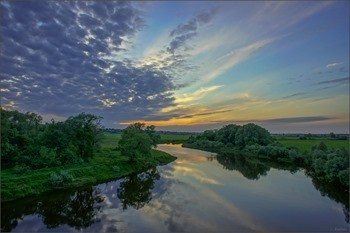
Description, what kind of fish is found, how to get there:
The river has clean water and a lot of fish. Fishermen can count on roach, pike, chub, bream, silver bream, crucian carp, dace, carp, gudgeon, tench, bleak, perch and ruff. The most fishing places are located in the Suzdal district of the Vladimir region. The fishermen will definitely not leave here empty-handed.
GPS coordinates: 56.74921, 39.49553
Klyazma River
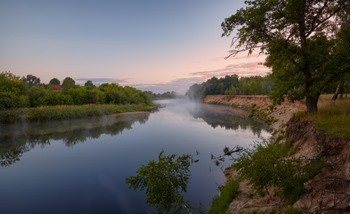
Description, what kind of fish is found, how to get there:
The Klyazma River is quite deep and has many tributaries; fishing here will bring great pleasure to both experienced fisherman and beginners. In addition to the predator, roach, ide, bream, and gudgeon will be a worthy catch. A predator can easily be interested in a wobbler or spinner, but bloodworms and worms will attract the attention of other inhabitants of the reservoir.
GPS coordinates: 56.13965, 40.47473
4. Kolp River
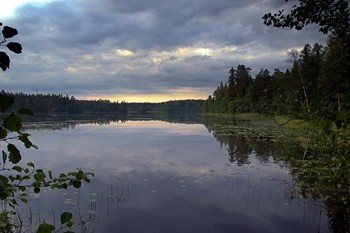
Description, what kind of fish is found, how to get there:
The Kolp River is relatively small: its length is about 100 km. Fishing on this river is varied. The river is home to pike, bleak, perch, roach, chub and rudd. Also, if you're lucky, you can catch crayfish. Now the water level in the river has risen sharply due to heavy rains in early July, which attracts fishermen.
GPS coordinates: 55.84626, 41.80569
5. Lake Kshara
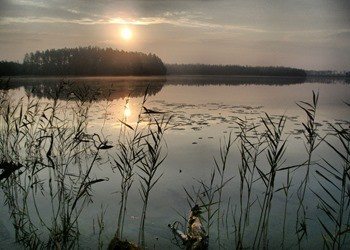
Description, what kind of fish is found, how to get there:
Lake Kschara is considered the deepest in the region. In several places the depth reaches almost 70 meters. The lake has clean and clear water, so it is rich in fish and crayfish. In Kschar you can catch pike, roach, perch, ruffe, burbot, ide, dace, silver carp, bleak, tench, gudgeon and golden crucian carp. It is known that the perches and pikes in the lake are famous for their large sizes.
GPS coordinates: 56.41527, 42.28944
Lake Vvedenskoye

Description, what kind of fish is found, how to get there:
Lake Vvedenskoye is excellent for active fishing. Here you can catch crucian carp, carp, tench, roach and bleak. Those fishermen who like to fish with spinning rods can count on pike and perch. The reservoir is slightly blown by the wind, which creates excellent conditions for comfortable fishing with mugs from a boat.
GPS coordinates: 55.92382, 39.11848
Lake Svyatoe
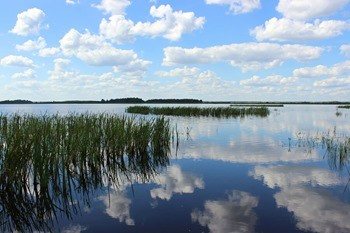
Description, what kind of fish is found, how to get there:
Lake Svyatoe is one of the largest lakes in the Vladimir region, where not only summer but also winter fishing is popular. The area of the water surface is about 700 hectares. The average depth of the reservoir is 2 meters, but there are holes more than 5 meters deep. The bottom is covered with very viscous silt.
Fishing in the waters of the lake is carried out for: roach, ide, bream, perch, pike.
These are the most common types of fish for which the Holy Lake is famous. Fishing is done not only from the shore, but also from a boat. And thanks to the presence of many islands in the lake, you can fish from there. Local fishermen will definitely tell you the most promising places. But they can change, since over many years the most catchy points can turn into a shallow overgrown with lush vegetation.
GPS coordinates: 55.37225, 40.18855
Lake Velikoye
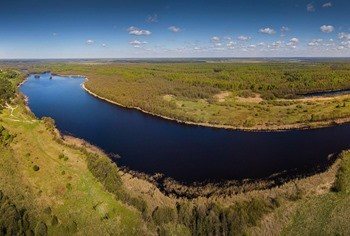
Description, what kind of fish is found, how to get there:
The lake called Velikoye is also famous among fishermen and outdoor enthusiasts. Large rotan, tench, pike and roach are often found in the reservoir. The bottom of the reservoir, although silted, does not have sharp changes and is quite flat. The muddy bottom does not hinder fishing, nor does the muddy water; it always passes at a height here.
GPS coordinates: 56.23305, 40.98944
Black Lake
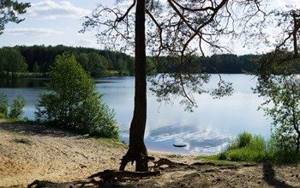
Description, what kind of fish is found, how to get there:
Lake Black is ideal for fishing for loach, rudd, crucian carp, bream, burbot, tench, roach, ide, pike and perch. In general, the reservoir is simply ideal for fishing. You can fish both from a boat and from the shore. The shore of the reservoir allows you to comfortably pitch your tent and stay for night fishing. The bottom of the reservoir is clean, so there is no need to break off the gear.
GPS coordinates: 55.92972, 39.15055
Lake Isihra
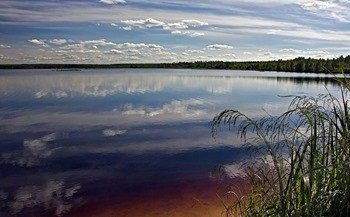
Description, what kind of fish is found, how to get there:
Lake Isihra is famous for fishing for roach, perch, ide and pike. The reservoir is quite shallow and has a marshy shore, as peat quarries are located nearby, but fishing is possible. True, fishing from a boat is much more convenient, but for those who don’t have one, fishing from the shore with feeder gear or spinning rod is also suitable.
GPS coordinates: 55.94085, 40.19183
Do you know any other good places for fishing in the Vladimir region - write in the comments
